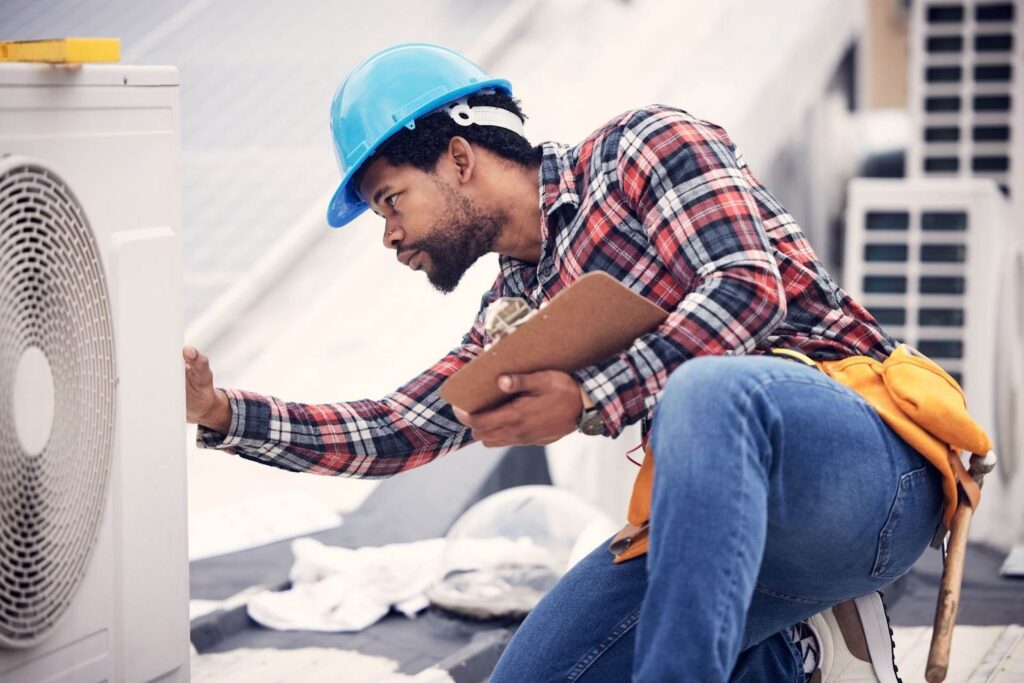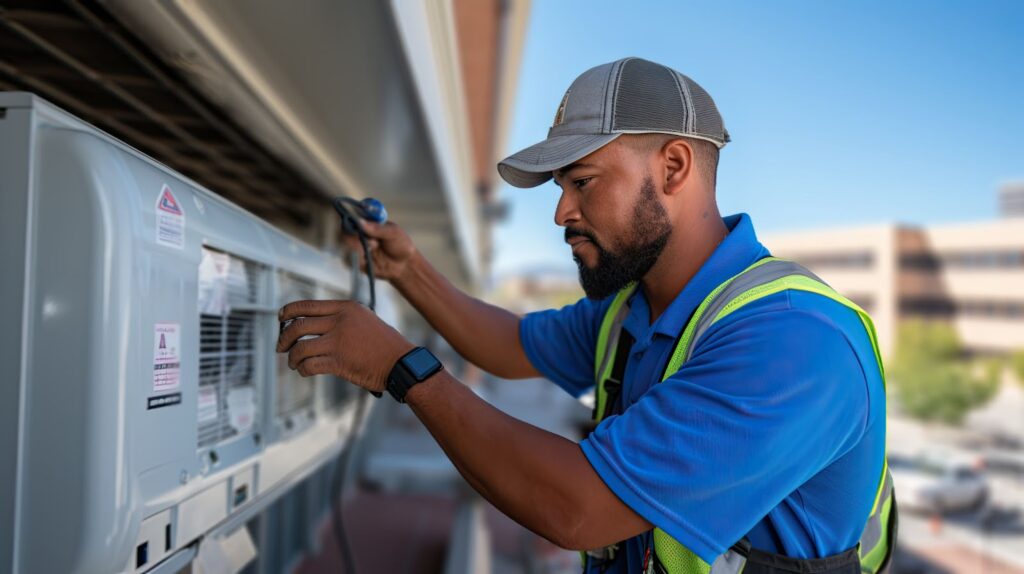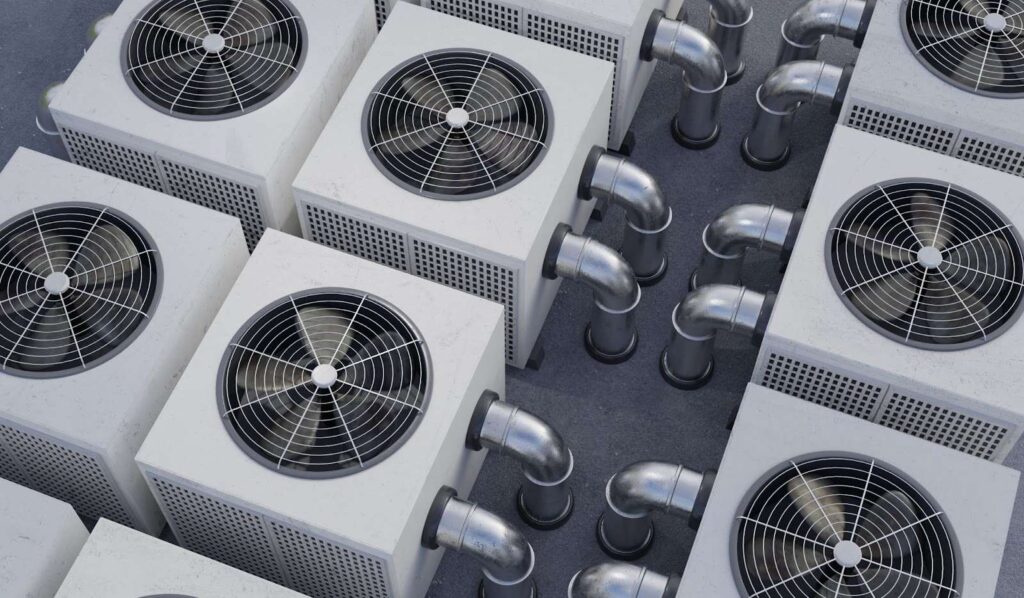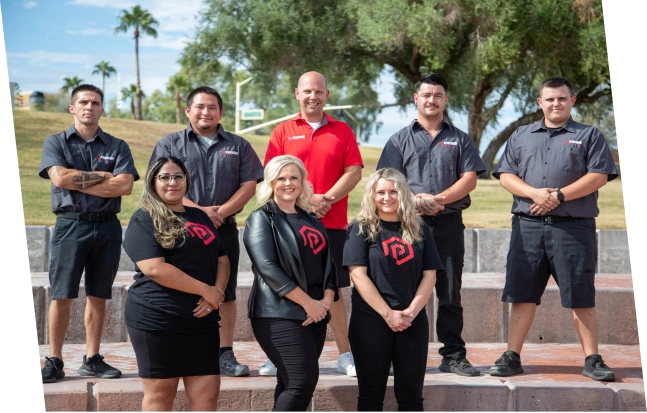Your home’s comfort depends on how well your heating and cooling system performs. That’s where SEER ratings come into play. If you’ve shopped for a new air conditioner or heat pump, you’ve seen those numbers slapped on yellow energy labels.
But what do they actually mean? And how do they affect your monthly bills, system lifespan, and comfort levels?
Ratings directly impact how much energy your AC or heat pump burns through every time it kicks on. Let’s break it down and make sense of what those numbers mean for your home and wallet.
What does SEER stand for?
SEER stands for Seasonal Energy Efficiency Ratio. It measures how efficiently your AC or heat pump cools your home over a typical season. Think of it as a miles-per-gallon rating for your cooling system. The higher the number, the more efficiently it runs.
To get technical for a second, these ratings compare the total cooling output (in BTUs) during a season to the total electric energy input (in watt-hours). But you don’t need to memorize the formula. You only need to know this: higher SEER ratings mean less electricity wasted while keeping your home cool.
Why SEER ratings matter for homeowners
When you switch on your air conditioner in July or your heat pump during spring, your system starts pulling power. The rating tells you how hard it has to work to maintain that cool, comfortable air. A low SEER rating means the unit draws more electricity and costs more to run. A high SEER unit gets the same job done while using less power.
That efficiency matters every time your system runs. Whether you’re blasting AC during a heatwave or using your heat pump for light heating in the fall, the SEER rating affects how much you pay. That’s why understanding this type of rating helps you make smarter choices when it’s time for a new system or an AC service upgrade.
What’s the minimum SEER rating today?
The Department of Energy sets the standards for SEER ratings based on region. As of 2023, the minimum SEER for new air conditioners in the southern United States is 15. In northern states, the minimum is 14. These numbers help push manufacturers to build more efficient systems.

Older systems — especially those installed more than 10 years ago — might have SEER ratings as low as 8 or 10. That means they burn nearly twice as much power as today’s models. If your system’s running nonstop and your bills keep climbing, low SEER could be the reason.
How do SEER ratings impact energy costs?
Your air conditioner uses a lot of electricity. So when your system runs inefficiently, your bills spike fast. A higher SEER rating trims energy use every time the system cycles on.
For example, replacing a 10 SEER unit with a 16 SEER model could save you hundreds per year on cooling costs, depending on how often you use it. The bigger your house and the hotter your climate, the more you save. Over 10 to 15 years, the difference adds up.
That’s why professional AC service technicians always recommend checking these ratings when considering a replacement. The upfront cost might be higher, but the long-term savings hit your wallet where it counts.
SEER ratings and the environment
Lower SEER systems burn more electricity, which increases the demand for power plants. That drives up greenhouse gas emissions and strains the electrical grid. If you care about reducing your carbon footprint, higher ratings help you do your part without sacrificing comfort.
Every kilowatt-hour saved keeps fossil fuels in the ground. So, by upgrading to a system with a higher SEER, you’re saving money and reducing your home’s environmental impact.
What about heating? Does SEER matter for that, too?
These ratings focus on cooling efficiency, but they also apply to heat pumps during mild heating seasons. Heat pumps cool and heat, so SEER impacts their overall performance. When your heat pump runs in heating mode during spring or fall, its SEER rating still matters.
For heavier heating loads — like winter in colder climates — look at the HSPF rating (Heating Seasonal Performance Factor) instead. That number measures heating efficiency the same way SEER does for cooling. Still, any discussion about professional heating services should include both ratings to make sure your system delivers year-round.
Should you always choose the highest SEER?
Not necessarily. While higher ratings mean better efficiency, they also come with higher upfront costs. A 21 SEER unit might sound perfect, but it might take 10 years or more to recover the extra money you spent upfront — especially if you live in a cooler climate where the AC doesn’t run often.
The sweet spot for most homes falls between 14 and 18 SEER. It all depends on your budget, your climate, your home’s insulation, and how long you plan to live there. A qualified AC service technician helps you find the best match for your situation — not the priciest model on the lot.
How SEER affects HVAC system sizing
SEER ratings tie into how a technician sizes your system. You don’t want a unit that’s too large or too small. Oversized units cycle too frequently, wasting energy and wearing out parts. Undersized systems run nonstop and still fall short of cooling your home.
When sizing a system, technicians use these ratings, home size, insulation levels, window types, and even sun exposure. That’s why professional HVAC teams never guess — they calculate.
An experienced AC service provider runs these numbers before making a recommendation. That precision ensures you don’t overpay for energy or repairs down the road.
How SEER connects to maintenance and service
Even high-SEER systems lose efficiency if they don’t get regular care. Dust buildup, blocked airflow, refrigerant leaks, or dirty coils all lower your system’s performance. A 16 SEER unit might perform like a 12 SEER if neglected.
Professional AC service keeps your unit operating close to its intended efficiency. Seasonal maintenance includes coil cleaning, airflow checks, and thermostat calibration. These tasks don’t simply extend your system’s life — they also protect the efficiency you paid for.
The same goes for heating. A neglected heat pump drops in efficiency fast. Reliable heating service helps protect your investment, prevent breakdowns, and maintain steady performance.
SEER ratings and smart thermostats
Smart thermostats don’t directly affect ratings, but they do help your high-efficiency system work smarter. These devices learn your schedule, adapt to your habits, and avoid wasteful temperature swings.
Pairing a high-SEER unit with a smart thermostat multiplies the benefits. It ensures your system runs only when needed and stays off when you’re away. That reduces energy use, lowers bills, and stretches the lifespan of your HVAC equipment.

Common SEER rating myths to ignore
Myth #1: Higher SEER always means better comfort.
Not always. SEER measures efficiency, not power or performance. Even a high-SEER system won’t cool a poorly insulated home.
Myth #2: Upgrading the outdoor unit alone boosts SEER.
Wrong. To achieve an accurate SEER rating, indoor and outdoor units must match. Mixing parts throws off balance and wastes energy.
Myth #3: SEER ratings stay consistent forever.
They don’t. Dust, wear, and poor maintenance drag efficiency down over time. That’s why scheduled AC and heating service matters year after year.
What to ask during a system quote
When it’s time to install or replace your system, don’t accept a generic quote. Ask about the SEER rating of every option. Ask how long it takes to recover costs through energy savings. Ask what maintenance the system needs to keep its rating over time.
A strong provider answers with confidence. They walk you through the math, help you compare options, and guide you toward the right balance of performance, efficiency, and price.
How rebates and incentives tie into SEER
Many utility companies and state energy programs offer rebates for high-efficiency systems. To qualify, your equipment often needs to meet a certain SEER threshold.
Ask your AC or heating service provider about local incentives.
They’ll help you find rebates that make a high-SEER upgrade more affordable. These savings ease the upfront cost and speed up your return on investment.
What the future holds for SEER ratings
Technology keeps improving. The industry pushes for even more efficient systems that save money and lower emissions. In the next few years, new standards and test procedures may raise the bar again.
Staying ahead of those changes helps future-proof your home. Installing a system with a strong SEER rating now prepares you for better comfort, lower energy costs, and stronger resale value if you ever sell your house.
Final thoughts
These ratings might seem like small numbers on a label, but they carry serious weight. They affect how much energy your HVAC system uses, how much you pay on your electric bill, and how long your system lasts. Whether you’re due for a replacement or need routine AC or heating service, knowing your SEER rating helps you make smarter choices.
A system with the right SEER rating gives you better efficiency, stronger performance, and reliable comfort throughout every season. Talk to a trusted HVAC expert. Ask questions. Review the numbers. Make the kind of decision your future self will thank you for.
Stay comfortable year-round with help from Paragon Service Pros
When your home’s comfort depends on a well-running HVAC system, trust the team that knows how to keep it performing at its best. Paragon Service Pros delivers dependable heating and AC services built around your needs, not cookie-cutter solutions.
Our skilled technicians handle seasonal maintenance with precision, making sure your system stays efficient, safe, and ready for whatever weather hits. Don’t let surprise breakdowns disrupt your day. Stay ahead of the issues with expert care.
Book your HVAC service with Paragon Service Pros today — online or by phone at 385-396-5811 and keep your system running strong every season.



